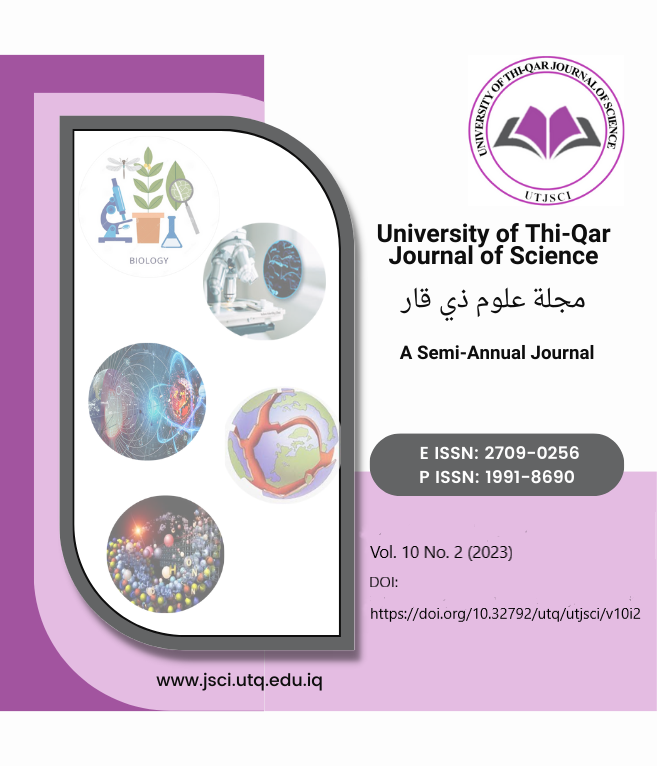Pathogenic Bacteria Isolated from House Flies and Compared with Pathogenic Bacteria Isolated from Children with Diarrhea
DOI:
https://doi.org/10.32792/utq/utjsci/v10i2.1107Abstract
House flies carry many disease-causing bacteria. Through this study, we will find the relationship between house flies and bacteria that cause diarrhea in children. A total of three hundred and fifty flies were collected from (butchers, chicken and fish shops, markets, house and hospitals) and 200 samples were collected from children with diarrhea from each of Shatrah and Nasiriyah Governorate during the research period from July 2022 to January 2023 in Thi-Qar Governorate. The current study showed that 126 (36.0 %) of the flies carried bacteria, while 224 (64.0 %) of them did not contain bacteria. The current study showed that the percentage of high isolated bacteria was from the internal content of flies (8.71%), followed by(5.57%), on the external surface of flies. the present study showed the high isolated bacteria were from butcher (4.29%), following in hospital (4.0%),while the lowest isolated bacteria from flies collected from houses( 2.86%), The current study showed that the most isolated bacteria is E. coli with a percentage of( 24.3%), followed by S. aureus (17.0%), followed by Klebsiella. spp (13.15%), while the least isolated bacteria is Micrococcus (3.94%).When comparing the bacteria present in flies with the bacteria isolated from pediatric patients with diarrhea, these bacteria, the current study showed that the predominant bacteria was Escherichia coli from diarrhea with a percentage of (44.63%), and Escherichia coli was (36.27%) in the dominant flies. Staphylococcus aureus in flies followed (25.49%)
Received: 2023-08-16
Revised: 2023-09-05
Accepted: 2023-09-06
References
V. Manjithkumar, K. P. Sanjayen, P. Martin, K. E. And, and M. G. Ragunathan, “Lethal Toxicity Studies Of Chemical And Botonical Pesticides Against Vector Musca Domestica (Linnaeus, 1758) (Diptera: Muscidae),” World J. Pharm. Res., vol. 7, no. 9, pp. 1107–1113, 2018, doi: 10.20959/wjpr20189-12158.
J. H. Frank and J. Goddard, Infectious Diseases and Arthropods, vol. 83, no. 3. 2000. doi: 10.2307/3496366.
J. Knox, A. C. Uhlemann, and F. D. Lowy, “Staphylococcus aureus infections: Transmission within households and the community,” Trends Microbiol., vol. 23, no. 7, pp. 437–444, 2015, doi: 10.1016/j.tim.2015.03.007.
R. D. Moon, Muscid flies (muscidae), no. 1985. Elsevier Inc., 2018. doi: 10.1016/B978-0-12-814043-7.00017-0.
A. Fukuda, M. Usui, M. Okamura, H. Dong-Liang, and Y. Tamura, “Role of Flies in the Maintenance of Antimicrobial Resistance in Farm Environments,” Microb. Drug Resist., vol. 25, no. 1, pp. 127–132, 2019, doi: 10.1089/mdr.2017.0371.
A. Sobur et al., “Molecular detection of multidrug and colistin-resistant Escherichia coli isolated from house flies in various environmental settings,” Future Microbiol., vol. 14, no. 10, pp. 847–858, 2019, doi: 10.2217/fmb-2019-0053.
A. H. Baqui et al., “Zinc therapy for diarrhoea increased the use of oral rehydration therapy and reduced the use of antibiotics in Bangladeshi children,” J. Heal. Popul. Nutr., vol. 22, no. 4, pp. 440–442, 2004.
R. Dehghani and H. Kassiri, “A brief review on the possible role of houseflies and cockroaches in the mechanical transmission of coronavirus disease 2019 (Covid-19),” Arch. Clin. Infect. Dis., vol. 15, pp. 1–4, 2020, doi: 10.5812/archcid.102863.
A. M. H. A. AL-Rhada, “Role of Musca domestica and Stomoxys calcitrans as a vector of Escherichia coli O157:H7 from different sites in Baghdad/ Iraq,” Mirror Res. Vet. Sci. Anim., vol. 5, no. 2, pp. 26–32, 2016.
A. A. J. Aljanaby and I. A. J. Aljanaby, “Prevalence of aerobic pathogenic bacteria isolated from patients with burn infection and their antimicrobial susceptibility patterns in Al-Najaf city, Iraq-A three-year cross-sectional study. [version 1; peer review: Awaiting peer review],” F1000Research, vol. 7, no. 3, pp. 1–14, 2018, doi: 10.12688/f1000research.15088.1.
W. A. Nazni, B. Seleena, H. L. Lee, J. Jeffery, T. A. T Rogayah, and M. A. Sofian, “Bacteria fauna from the house fly, Musca domestica (L.).,” Trop. Biomed., vol. 22, no. 2, pp. 225–231, 2005.
A. A. N. Al-shwelly and S. T. A. Al-gizy, “Contamination with Aerobic Bacteria Accompanying to Seeds of Triticum Aestivum . L that are Stored and Infected with Different Numerical Levels of Rusty Flour Beetle Insect Tribolium . Castaneum ( Herbest ) Coleoptera : Tenebrionidae,” Ann. R.S.C.B, vol. 25, no. 4, pp. 959–971, 2021.
M. L. Algorithms, “Tikrit Journal of Pure Science,” Tikrit J. Pure Sci., vol. 28, no. 1, pp. 82–88, 2023.
M. Kababian, E. Mozaffari, K. Akbarzadeh, R. S. Kordshouli, A. Saghafipour, and S. Shams, “Identification of bacteria contaminating musca domestica (Diptera: Muscidae) collected from animal husbandries,” Shiraz E Med. J., vol. 21, no. 4, pp. 1–8, 2020, doi: 10.5812/semj.92018.
R. Park et al., “Microbial communities of the house fly Musca domestica vary with geographical location and habitat,” Microbiome, vol. 7, no. 1, pp. 1–12, 2019, doi: 10.1186/s40168-019-0748-9.
A. Duga, “Research Article Research Article,” Arch. Anesthesiol. Crit. Care, vol. 4, no. 4, pp. 527–534, 2018, [Online]. Available: http://www.globalbuddhism.org/jgb/index.php/jgb/article/view/88/100
B. Hemmatinezhad, D. Ommi, T. T. Hafshejani, and F. Khamesipour, “Molecular detection and antimicrobial resistance of Pseudomonas aeruginosa from houseflies (Musca domestica) in Iran,” J. Venom. Anim. Toxins Incl. Trop. Dis., vol. 21, no. 1, pp. 1–5, 2015, doi: 10.1186/s40409-015-0021-z.
M. A. H. Al-khozaei and S. T. Ali, “The Role of House Flies in Transmitting Pathogenic Bacteria in some Thi-Qar Hospitals and Burn halls,” 2022.
M. Pava-Ripoll, R. E. G. Pearson, A. K. Miller, and G. C. Ziobro, “Prevalence and relative risk of Cronobacter spp., Salmonella spp., and listeria monocytogenes associated with the body surfaces and guts of individual filth flies,” Appl. Environ. Microbiol., vol. 78, no. 22, pp. 7891–7902, 2012, doi: 10.1128/AEM.02195-12.
Y. Zhang, P. Bi, and J. E. Hiller, “Climate variations and Salmonella infection in Australian subtropical and tropical regions,” Sci. Total Environ., vol. 408, no. 3, pp. 524–530, 2010, doi: 10.1016/j.scitotenv.2009.10.068.
A. Yousaf, N. Afzal, and S. Arshad, “Determination of antibiotic susceptibility patterns in urinary tract infections among Cancer patients,” Turkish J. Physiother. …, vol. 32, no. 10, pp. 1–14, 2021, [Online]. Available: https://www.researchgate.net/profile/Sohaib-Arshad-4/publication/356147970_Determination_of_antibiotic_susceptibility_patterns_in_urinary_tract_infections_among_Cancer_patients/links/618d5dda61f0987720814eda/Determination-of-antibiotic-susceptibility-patt
Downloads
Published
License
Copyright (c) 2023 University of Thi-Qar Journal of Science

This work is licensed under a Creative Commons Attribution 4.0 International License.













